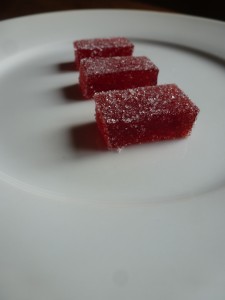Originally published December 14, 2013.
 Pâte de fruits, literally “fruit paste,” is a simple confection made of fruit, sugar, and pectin. Some recipes also use gelatin.
Pâte de fruits, literally “fruit paste,” is a simple confection made of fruit, sugar, and pectin. Some recipes also use gelatin.
Pâtes de fruits have a very distinct texture. They are firmer than a spreadable breakfast jelly, but without the persistent chew of a gummy bear or gummy worm or any other fauna from the gummy kingdom. One of my chefs compared the texture to a medium ganache.
Another distinction between true pâte de fruits and inferior industrial candies is flavour. They are very bright, pure expressions of the fruit from which they are made. They tend to be tart, though well-balanced.
The chemistry behind pâtes de fruits is the same as that behind jellies (see this post). We require three things to form good pectin bonds:
- heat, to evaporate moisture and concentrate the pectin
- acid (hydrogen ions), to neutralize the negative charge that repels pectin molecules
- sugar, to draw in moisture and make room for the pectin molecules to get intimate
The only difference between a spreadable jelly and this jelly candy is the concentration of the above-listed ingredients. The real trick is finding the right pectin content: too little and the paste will not cut into clean squares, too much and they will be very firm and have a slightly mealy texture on the tongue.
Estimating the required pectin quantity is especially hard if you are using fresh fruit. Bakery supply shops carry fruit concentrates designed to be used in this type of confectionery, and each is carefully blended to have uniform characteristics across batches. Fresh fruit, however, is not and cannot be controlled in this manner. Pectin content varies from plant to plant and within the same plant as the fruit ripens.
I’ve been trying to make a great Evans cherry pâte de fruits for some time now. For the Eat Alberta 2013 tasting board I set out to make a pâte de fruits with some of the Evans cherries left in my freezer from last season. I wanted to give folks a really clear idea of what our sour cherries taste like. Since we were still three or four months away from having fresh cherries, I thought that jelly candy was the best way to do this.
I have omitted extra acid such as citric acid solution from the recipe because I think that Evans cherries are plenty sour on their own.
I’ll share two more details before leaving you with the recipe. First: boil the jelly very aggressively. This preserves a lot of the flavour of the fresh fruit. Second: when selecting a dish to pour the jelly into to set, pick one that is a size that will make your jelly candies about 1/2″ high. Making the candies too flat makes them hard to pick up.
Evans Cherry Pâte de Fruits
Ingredients
- 450 g Evans cherry juice
- 170 mL Certo liquid pectin
- 450 g granulated sugar
Procedure
- Very lightly grease an 8″ x 8″ glass casserole with canola oil.
- Warm the cherry juice in a heavy pot. Once warm (~140°F) whisk in the liquid pectin.
- Bring cherry mixture to a boil. Add the sugar in three parts, returning the liquid to a boil between each addition.
- Crank the heat and boil aggressively until a candy thermometer reads 222°F. Skim away any foam that appears on the surface.
- Working quickly, pour the cherry mixture into the lightly greased casserole.
- Cool at room temperature until firm and easy to handle, roughly 30 minutes.
- Sprinkle granulated sugar over the surface of a cutting board. Turn out the set cherry mixture onto the cutting board. Sprinkle the top of the cherry mix with more sugar.
- Cut into desired shapes.
- Store completely submerged in granulated sugar for 24 hours.
- Remove pate de fruits from sugar and shake off excess. Place on a wire rack and leave uncovered at room temperature for 24 hours to dry further.
Can you imagine if Edmonton restaurants started serving these when they brought you the cheque, instead of a mint?